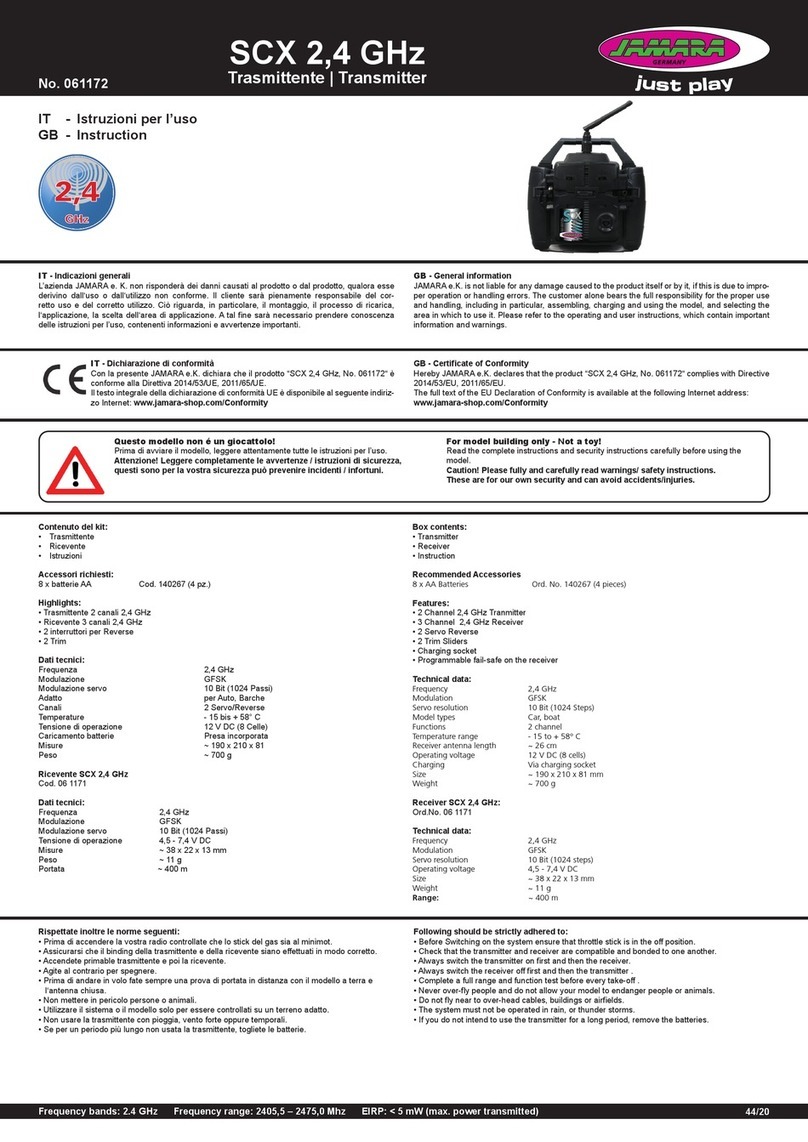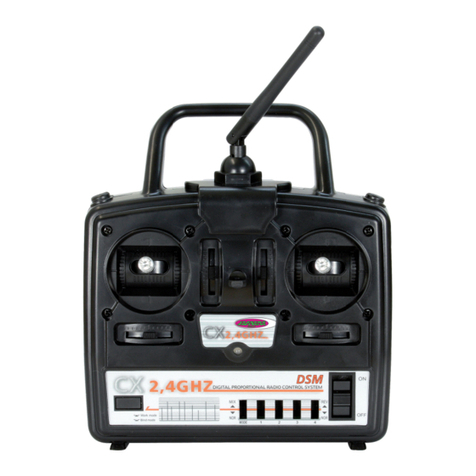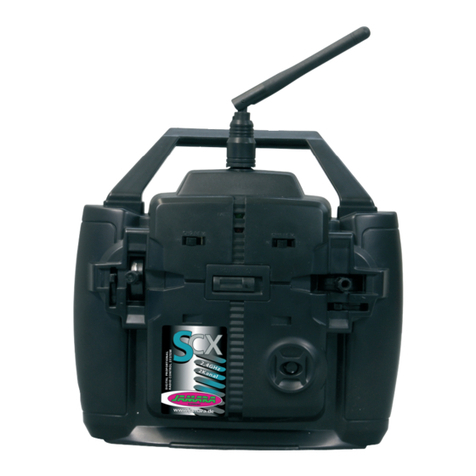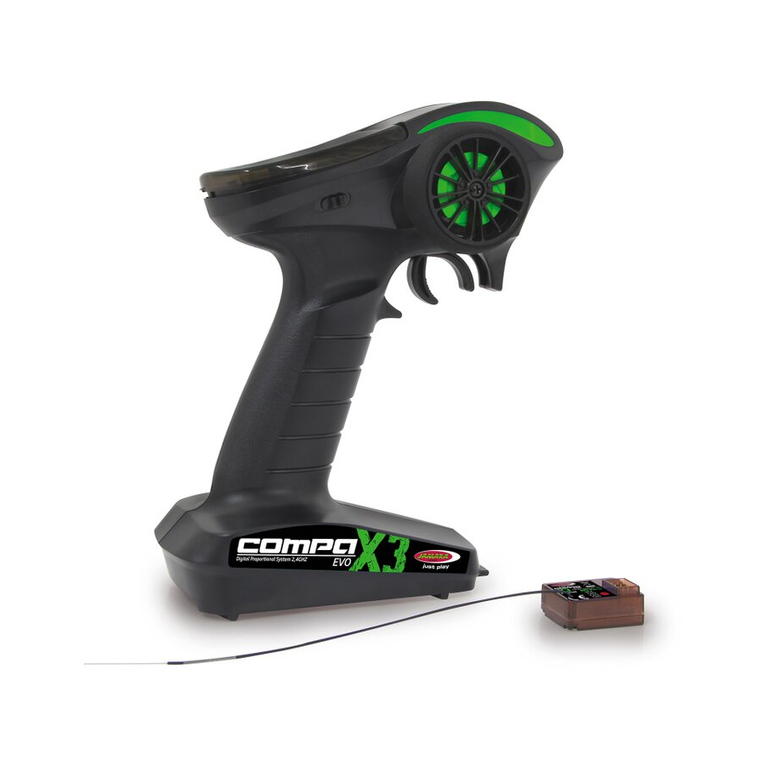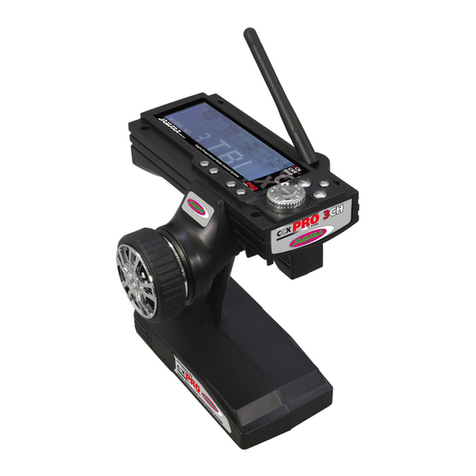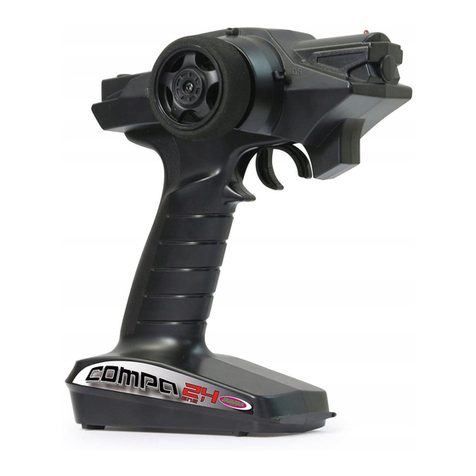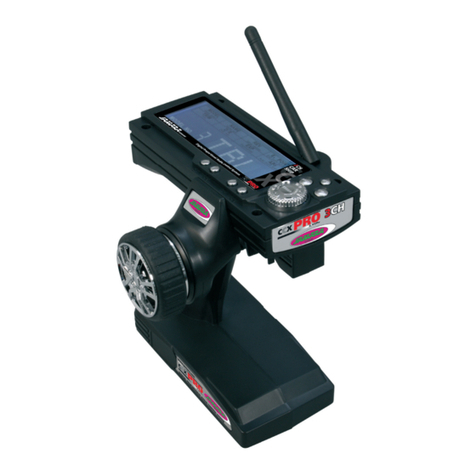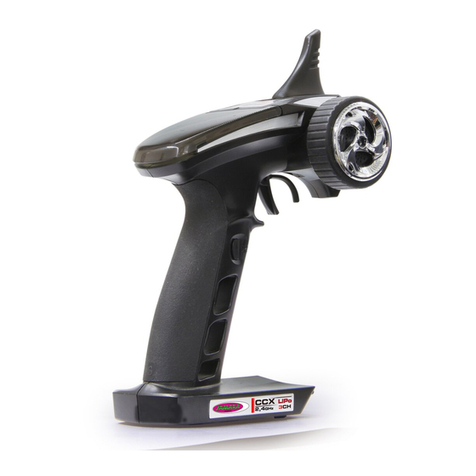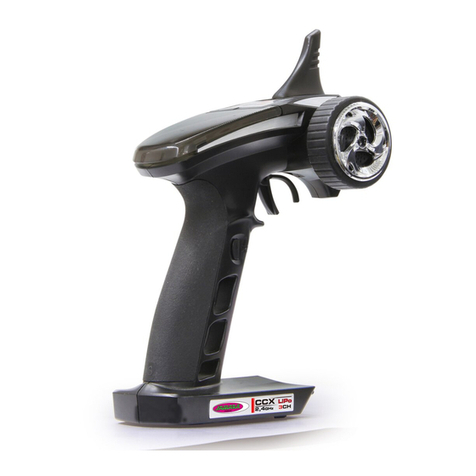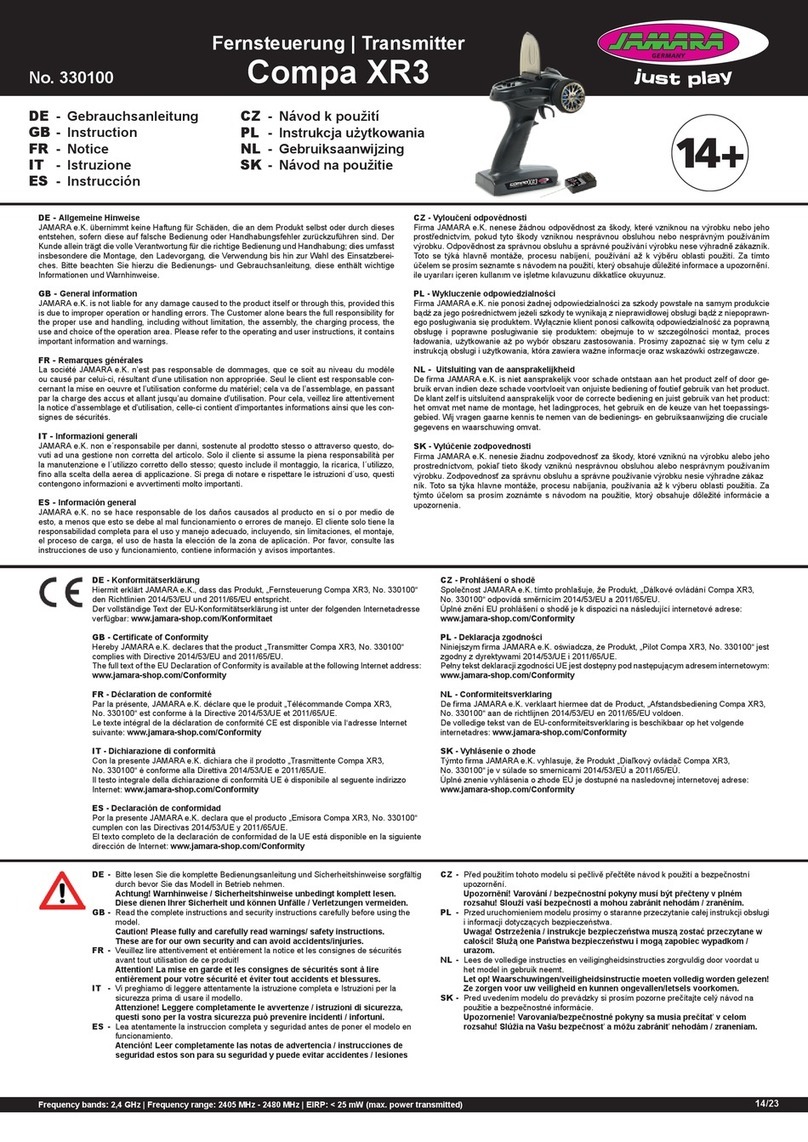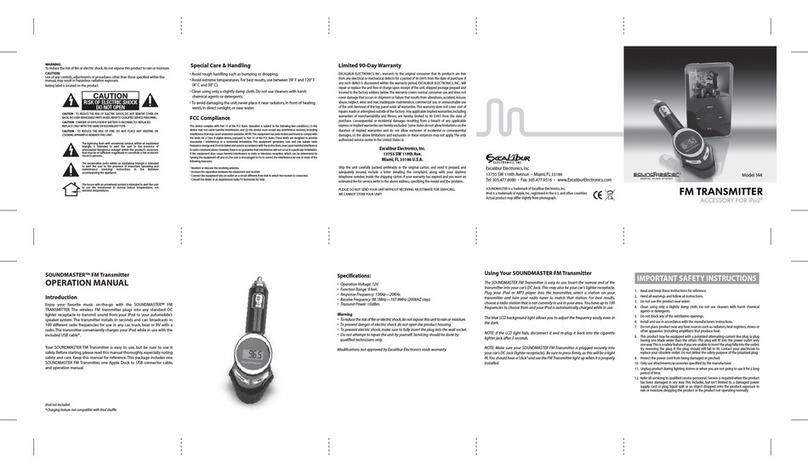
FR - Mode d‘emploi
GB - Instruction
CCX Pro 2,4 GHz
Emetteur | Transmitter
No. 061200
44/20
FR - Consignes générales
La société JAMARA e. K. n‘assume aucune responsabilité des dommages subis par le produit ou
occasionnés par le produit si ces dommages résultent d‘un emploi ou utilisation incorrects. Le
Client est lui-même responsable de l‘emploi et utilisation corrects, ceci comprenant en particulier
le montage, le processus de chargement, l‘application et le champ d‘application. Il faut prendre
connaissance du contenu du mode d‘emploi qui contient des informations importantes et des indi-
cations d‘avertissement.
GB - General information
JAMARA e.K. is not liable for any damage caused to the product itself or by it, if this is due to impro-
per operation or handling errors. The customer alone bears the full responsibility for the proper use
and handling, including in particular, assembling, charging and using the model, and selecting the
area in which to use it. Please refer to the operating and user instructions, which contain important
information and warnings.
FR - Déclaration de conformité
Par la présente, JAMARA e.K. déclare que le produit “CCX Pro 2,4 GHz, No. 061200“
est conforme à la Directive 2014/53/UE, 2011/65/UE.
Le texte intégral de la déclaration de conformité CE est disponible via l‘adresse Inter-
net suivante: www.jamara-shop.com/Conformity
GB - Certicate of Conformity
Hereby JAMARA e.K. declares that the product “CCX Pro 2,4 GHz, No. 061200“ complies with
Directive 2014/53/EU, 2011/65/EU.
The full text of the EU Declaration of Conformity is available at the following Internet address:
www.jamara-shop.com/Conformity
Contenu du kit:
• Radiocommande
• Récepteur
• Notice
Accessoires nécessaires
8 x piles AA Réf. 140267 (UV. 4pcs)
Ce système ouvre les portes à une nouvelle dimension dans le monde du modélisme voiture.
Nous avons repris la technologie de transmission 2,4 GHz dans notre CCX. Un afcheur
énorme et une programmation très simple ajoutent à l‘efcacité de notre émetteur.
Equipement:
• 3 canaux complètement programmables
• Système 2,4 GHz
• Dual Rate
• Inversion du sens de rotation des servos
• Ajustement de la position centrale des servos
• Résolution 1024
• 100mW hopper de fréquence
• 10 mémoires de modèles pouvant êtres nommées
• Courbe Expo réglable
• Fonction ABS 3 positions réglables
• Programmation par roue Jog / Dial
• Rétroéclairage de l’afcheur
• Indicateur de tension avec alarme acoustique de sous-tension
• Compatible avec les récepteurs CCX existants
• Prise de charge
• Prise jack 3,5mm pour branchement du simulateur
• Dimensions 159 x 127 x 196 mm
• Poids 405 g
• Fail-Safe programmable sur le récepteur
• Display: 100 x 35 mm
Données techniques:
Bande de fréquence 2,4 GHz
Canaux 3
Type de modulation GFSK
Résolution pour servo 10 bits (1024 pas)
Alimentation 4,5 – 7,4 V DC
Dimensions 37 x 22 x 13 mm
Poids 7,6 g
Box contents:
• Transmitter
• Receiver
• Instruction
Recommended Accessories
8 x AA Batteries Ord. No. 140267 (4 pieces)
This transmitter sets new standards in the RC-Car area. The established 2.4 GHz technology from
our CCX car radio was adopted into the CCX Pro. A huge display and easy programming complete
this transmitter.
Features:
• 3ch fully programmable
• 2,4GHz System
• Dual Rate
• Servo reverse
• Adjustment of servo centre and travel
• 1024 display resolution
• 100mW Frequency hopper
• 10 model memory
• Adjustable Expo
• 3 stage ABS setting
• Programming by Jog/Dial wheel
• Display backlight
• Voltage indicator with audible low voltage warning
• Compatible with CCX receivers
• Charging socket
• 3,5mm jack and simulator connection
• Weight 405 g
• Dimensions 159 x 127 x 196 mm
• Programmable Fail Safe on receiver
• Display: 100 x 35 mm
Technical data:
Frequency 2,4 GHz
Modulation AFHDS
Operating voltage 4,8 - 7,4 V DC
Servo resolution 10 Bit (1024 steps)
Dimensions 37 x 22 x 13 mm
Weight 7,6 g
Ce modèle réduit n’est pas un jouet!
Avant de mettre en marche toute l‘unité il faut lire attentivement le mode d‘emploi.
Attention! La mise en garde et les consignes de sécurités sont à lire
entièrement pour votre sécurité et éviter tout accidents et blessures.
For model building only - Not a toy!
Read the complete instructions and security instructions carefully before using the
model.
Caution! Please fully and carefully read warnings/ safety instructions.
These are for our own security and can avoid accidents/injuries.
Veillez respecter les consignes suivantes:
• Avant de mettre en marche votre récepteur, assurez-vous que le manche des gaz soit bien en
position Off.
• Assurez-vous que l’émetteur et le récepteur soient compatibles et se trouvent mutuellement.
• Allumez toujours l‘émetteur en premier, puis le récepteur.
• Eteignez toujours le récepteur en premier puis votre radiocommande.
• Effectuez toujours un test de porté et de bon fonctionnement avant le décollage.
• Ne survolez jamais des personnes, ne mettez jamais en danger les gens ou les animaux.
• N‘utilisez le système ou le modèle à contrôler que sur un terrain adapté.
• N’utilisez jamais votre émetteur lorsqu’il y a une tempête, qu’il pleuve ou par orage.
• Sortez les piles de votre émetteur lorsque vous n’utilisez plus votre équipement.
Following should be strictly adhered to:
• Before Switching on the system ensure that throttle stick is in the off position.
• Check that the transmitter and receiver are compatible and bonded to one another.
• Always switch the transmitter on rst and then the receiver.
• Always switch the receiver off rst and then the transmitter .
• Complete a full range and function test before every take-off .
• Never over- y people and do not allow your model to endanger people or animals.
• Do not y near to over-head cables, buildings or air elds.
• The system must not be operated in rain, or thunder storms.
• If you do not intend to use the transmitter for a long period, remove the batteries.
Frequency bands: 2.4GHz Frequency range: 2405,5 – 2475,0 MHz EIRP: < 30 mW (max. power transmitted)

